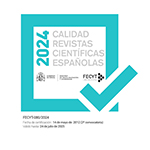Riesgos medioambientales: los virus. La frontera entre lo clásico y lo cuántico
Resumen
Los virus son cuasiespecies que necesitan un hospedador para poder replicar su RNA y sobrevivir. Parasitan a todo tipo de especies; en algunos casos no provocan ningún daño a su hospedador, y en otros pueden llegar a provocar la muerte de este, aunque sea indirectamente por los daños que acaba provocando y las reacciones inmunes que desarrollan los hospedadores. Viven en un mundo que se encuentra en el umbral de lo clásico y lo cuántico. Pueden vivir en el vacío y sin oxígeno, pero necesitan las condiciones que se dan en nuestro mundo para poder evolucionar, mutar y sobrevivir. Su forma de vida hace que se rijan por condicionantes cuánticos y siguiendo sus leyes. Eso nos obliga a luchar contra ellos con herramientas de la física clásica, dentro del mundo cuántico en el que viven. Este artículo busca encontrar ese umbral, y poder así, entender mejor a lo que nos estamos enfrentando, y si el estado del arte actual es el correcto para poder dar una solución satisfactoria. Las células de los seres vivos y los virus libran una guerra que dura millones de años, y aunque los sistemas inmunológicos de la mayoría de los seres vivos han evolucionado para rechazar esa amenaza, en muchas ocasiones sucumben, y se hace necesaria la ayuda exterior mediante profilaxis adecuadas a cada caso. El deterioro imparable de los ecosistemas que nos rodean, debido sobre todo al desequilibrio que hemos introducido en ellos, hace que los virus lo tengan más fácil para pasar de especie a especie, ya que los hospedadores naturales, que reducen la carga viral, en muchas ocasiones han desaparecido.
Descargas
Descarga artículo
Licencia
La revista Anales de Geografía de la Universidad Complutense, para fomentar el intercambio global del conocimiento, facilita el acceso sin restricciones a sus contenidos desde el momento de su publicación en la presente edición electrónica, y por eso es una revista de acceso abierto. Los originales publicados en esta revista son propiedad de la Universidad Complutense de Madrid y es obligatorio citar su procedencia en cualquier reproducción total o parcial. Todos los contenidos se distribuyen bajo una licencia de uso y distribución Creative Commons Reconocimiento 4.0 (CC BY 4.0). Esta circunstancia ha de hacerse constar expresamente de esta forma cuando sea necesario. Puede consultar la versión informativa y el texto legal de la licencia.












